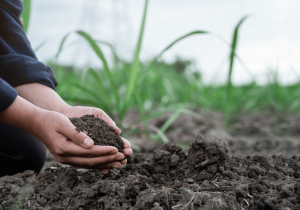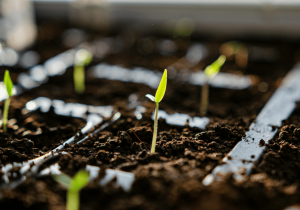Spring is right around the corner, and for home gardeners, it’s the most exciting time of the year. The prospect of fresh blooms, home-grown produce, and lush greenery makes all the prep work well worth it. Whether you’re a seasoned gardener or just starting your green thumb journey, a little preparation can set your garden up for success this spring. This post will guide you through step-by-step tips to assess, clean, and prepare your garden to make the most of the growing season. By the end, you’ll be ready to transform your outdoor space into a vibrant haven.
Step 1: Assess Your Garden
Before you get started, take a good look at your garden’s current condition. This evaluation will help you understand what it needs to thrive this spring.
 Evaluate Soil Condition
Evaluate Soil Condition
Healthy soil is the foundation of a productive garden. Check whether your soil is compacted, dry, or overly moist. A simple soil test can measure its pH levels and nutrient content. You can pick up a soil testing kit at a local garden center or send a sample to a lab for more detailed results.
If your soil’s pH is off-balance or it’s lacking in essential nutrients (e.g., nitrogen, phosphorus, or potassium), you’ll need to amend it—more on that shortly!
Assess Sunlight and Shade
Notice how much sunlight your garden receives throughout the day. Does your garden space get filtered light? Is it mostly shady or fully exposed to the sun? Different plants have varying sunlight requirements, so understanding your yard’s conditions is key to choosing the right crops and flowers.
Measure Garden Space
Take stock of the layout and available space in your garden, including raised beds, pots, or patches of earth. Proper spacing is crucial to avoid overcrowding and to ensure your plants have adequate air circulation and nutrition.
Step 2: Clean Up the Garden
A tidy garden makes a great starting point for spring planting. Roll up your sleeves and tackle winter’s leftovers.
Remove Debris
Clear away fallen leaves, twigs, and dead plants from last year’s harvest. These can house pests, fungi, or diseases that threaten your new crops. Compost what’s compostable, but dispose of any diseased or pest-ridden materials to avoid reintroducing problems.
Prune Old Growth
Cut back dead or damaged branches from perennials, trees, and shrubs. This will stimulate healthy new growth for the spring. Be sure to use clean pruning shears to avoid spreading diseases between plants.
Weed Thoroughly
Remove weeds down to the roots. Spring weeds can quickly take over, so this is your chance to reclaim your garden space. Mulch can help suppress weeds after cleanup.
Step 3: Prepare the Soil
Preparing your soil is one of the most crucial steps before planting. Plants rely on nutrient-rich, well-draining soil to grow strong.
Add Compost and Organic Matter
Work organic matter like compost, aged manure, or leaf mould into the soil. These additions boost nutrients and improve soil texture. Compost also helps the ground retain moisture while preventing waterlogging.
Loosen the Soil
If the soil feels compacted, loosen it with a spade or garden fork. Good aeration allows roots to spread easily and ensures proper water and nutrient absorption. Aim to loosen the soil to at least 12 inches deep.
Apply Fertilizer (if needed)
Based on the results of your soil test, consider adding a balanced fertilizer or specific nutrients your plants may need. For example, bone meal is excellent for phosphorus, while fish emulsion adds nitrogen organically.
Step 4: Plan Your Planting
Now that your garden is primed, it’s time to decide which plants will fill it with life.
Choose Plants Suited for Your Zone
Research plants that grow well in your region’s climate and hardiness zone. Native plants and seasonal vegetables are generally great options as they’re already adapted to your area.
Plan Companion Pairings
Some plants do better when paired closely with others. For instance, marigolds repel pests and make great companions for tomatoes. Similarly, basil planted alongside peppers can enhance flavours and keep away bugs.
Rotate Crops
If you’re growing vegetables or fruits, consider crop rotation. This involves planting different crops in spots where they weren’t grown last year, preventing soil nutrient depletion and reducing the risk of pests.
 Step 5: Start Seeds Indoors
Step 5: Start Seeds Indoors
Why wait for garden-ready temperatures when you can get a head start? Starting seeds indoors lets you grow healthy seedlings to transplant when the conditions are right.
Pick the Right Seeds
Choose vegetables, herbs, or flowers that transplant well, such as tomatoes, peppers, lettuce, marigolds, or zinnias. Check the seed packet for the ideal start time for your region.
Use Quality Seed-Starting Mix
Avoid regular potting soil—it’s often too dense. Instead, go for a light and airy seed-starting mix that allows young roots to grow freely.
Provide Proper Conditions
Place seed trays in a warm spot with plenty of light—ideally near a sunny window or under grow lights. Keep the soil moist but not drenched, and follow the recommended germination instructions.
Step 6: Maintain Your Tools
Don’t overlook your gardening tools! Well-maintained tools can make your spring planting much more efficient.
Sharpen and Clean Tools
Use a file to sharpen edges on spades, shears, and hoes. Remove rust and clean items with soapy water and a brush. A quick wipe-down with an oil-soaked cloth can prevent metal from rusting further.
Inspect Equipment
Check hoses, watering cans, and irrigation systems to ensure everything’s in working order. Replace cracked hoses or broken parts to avoid interruptions mid-season.
Organize Your Workspace
Finally, lay out your tools so they’re easy to access. Whether you use a tool shed or a storage bin, an organized setup saves time and reduces frustration.
Spring is the perfect time to reconnect with nature and breathe new life into your garden. By evaluating your space, cleaning up debris, preparing the soil, making thoughtful planting decisions, and maintaining your tools, you set the stage for a successful growing season. Whether you’re dreaming of juicy sun-ripened tomatoes, fragrant herbs, or a vibrant flower garden, these simple steps will help your garden flourish. Don’t wait—get digging today and watch your garden thrive this spring.

